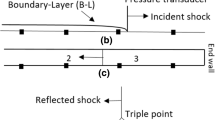Abstract
This article deals with video inspection of nuclear plant reactor after fuel reloading. During these underwater inspections, the fuel assemblies’ heat generates turbulence effect that sensitively degrades the video quality. An on-line restoration algorithm is proposed here. It consists of two steps. A temporal infinite impulse response filter is first used to get a stabilized but blurry video. A second spatial Wiener deconvolution filter is then used to estimate the video which would have been observed without turbulence. This second filter is based on a probabilistic model of the turbulence impact on the observed video. An on-line prototype, based on this algorithm and its straightforward extension to a moving camera (translation), has been successfully tested on several power plants.






Similar content being viewed by others
References
Frakes, D.H., Monaco, J.W., Smith, M.J.T: Suppression of atmospheric turbulence in video using an adaptive control grid interpolation approach. In: IEEE Conference Proceedings on Acoustics, Speech and Signal Processing vol. 3, pp. 1881–1884 (2001)
Gepshtein, S., Shtainma, A., Fishbain, B., Yaroslavski, L.P.: Restoration of atmospheric turbulent video containing real motion using rank filtering and elastic image registration. In: Proceedings of European Signal Processing Conference, vol. 1, pp. 477–480 (2004)
Gilles, J.: Restoration algorithm and system performance evaluation for active imaging systems. In: Proceedings SPIE Security and Defense (2007)
Gilles, J., Dagobert, T., De Franchis, C.: Atmospheric turbulence restoration by diffeomorphic image registration and blind deconvolution. In: ACIVS 2008, LNCS 5259, pp. 400–409 (2008)
Mao, Y., Gilles, J.: Non rigid geometric distortions correction—application to atmospheric turbulence stabilization. Inverse Probl. Imaging J. 6(3), 531–546 (2012)
Zhu, X., Milanfar, P.: Removing atmospheric turbulence via space-invariant deconvolution. IEEE Trans. Pattern Anal. Mach. Intell. 35(1), 157–170 (2013)
Paul, N., de Chillaz, A.: Processing of image data comprising effect of turbulence in a liquid medium. In: EDF Patent Published with Number WO/2012/101355 (2012, August 2nd) Under French Priority FR 2 971 075 (2011, January 28th)
Author information
Authors and Affiliations
Corresponding author
Appendices
Annex 1: Extension to a translating camera
In practical situation, the camera often translates above the fuel assembly (see example in Fig. 6). In such case, the temporal filter described in Sect. 3.1 no longer works and has to be adapted. Since the camera remains parallel to a flat observed scene, the correct weighted average of the successive frames is given by:
where
-
\(N_\mathbf{x}\) is the number of past images containing pixel x,
-
\(\delta _{n/n-k} \) is the two-dimensional shift between the current original image \(\mathbf{I} ( \mathbf{x},n)\) and the past original image \(\mathbf{I} ( \mathbf{x},n\!-\!k)\),
-
\(\mathbf{I} ( {\mathbf{x}+\delta _{n/{n-k}} ,n-k})\) is the image resulting from the translation of the original image \(n-k\) (with \(\mathbf{I} ( {\mathbf{x}+\delta _{n/{n-k}} ,n-k})=0\) if \(\mathbf{x}+\delta _{n/{n-k}} \) is out of the image bounds).
As in Sect. 3, \(I_\alpha (\mathbf{x},n)\) in Eq. (19) can be computed recursively, using the two following steps:
Any classical method can be used to calculate the shift \(\delta _{n/n-1} \) between the current original image I(x,\(n\)) and the previous original image I(x,\(n-1\)). In our prototype, \(\delta _{n/n-1} \) is the two-dimensional vector which maximizes the intercorrelation between I(x,\(n\)) and I(x,\(n-1\)). Once \(\delta _{n/n-1} \) has been calculated, \(\mathbf{I}_\alpha ( {\mathbf{x},n})\) is obtained with operations (20) and (21). Finally, \(\mathbf{I}_\alpha ( {\mathbf{x},n})\) is the input for the spatial deconvolution filter described in Sect. 3.2 (the spatial filter is the same as in the fix camera case). An example of restoration performance in the case of a moving camera is provided in Fig. 6
Annex 2: Impact of the turbulence pdf model
The spatial deconvolution filter described in Sect. 3.2 is mainly based on our assumptions on the turbulence pdf. In Figs. 7 and 8, the Laplacian model we selected (Sect. 2.1) is compared to a Gaussian isotropic model and a Cauchy isotropic model:
For each model, \(\sigma \) is manually optimized to provide the best restoration quality. Both the Cauchy and the Laplace model outperform the Gaussian model. The Cauchy model and the Laplace model have quite similar performances with a slight advantage for the Laplace model which provides more contrasts.
Rights and permissions
About this article
Cite this article
Paul, N., de Chillaz, A. & Collette, JL. On-line restoration for turbulence degraded video in nuclear power plant reactors. SIViP 9, 601–610 (2015). https://doi.org/10.1007/s11760-013-0497-3
Received:
Revised:
Accepted:
Published:
Issue Date:
DOI: https://doi.org/10.1007/s11760-013-0497-3






